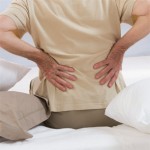Core strengthening exercises are another way to improve spine and back health. Many people think of the core muscles as movers and rotators; however, their main purpose is to stabilize and control the spine. To improve core strength without causing back pain, the trunk/spine should remain stable while engaging the abdominal muscles, then attempting to move the extremities while maintaining that control and stabilization, Dr. Schoenhals says.
Treatment
Generally speaking, a patient who presents with back pain should work on stabilization and strength. “Usually when we see patients in the clinic for a first episode of low back pain, we work with them on reducing pain, pain-free core stabilization exercise, stretching, and a return to activity, such as sport-related or general activity,” Dr. Goode says.
If someone sits for eight hours, suggest they get up and walk around or go somewhere they can lie down to relieve the pressure from their low back sporadically throughout the day.
—Sarah Schoenhals, DPT, PT
Exercise therapy is a common method for treating back pain, although research has shown that aquatic therapy can be more effective for reducing disability and improving quality of life compared with land-based therapy.7 “People find a lot of relief from being in the pool,” Dr. Schoenhals says. “It relieves your joints and the buoyancy of the water takes off the pressure of your body weight.”
For recurring pain, finding out what the patient has done in the past to relieve symptoms is a good starting point. “Then the issue becomes, Are they continuing to perform those exercises even after the low back pain is gone?” Dr. Goode says. “We educate them to work on core stabilization and strength even after the episode because it can help prevent the next occurrence.”
The lower back is the most common location of back pain, Dr. Schoenhals says, and posture is key for alleviating that pain and preventing recurrence, especially during functional movement. This becomes useful and important to remember during common activities at home, Dr. Schoenhals notes (see Figures 1 and 2–3).
When a patient presents with back pain in addition to rheumatic disease, diagnosing the cause in terms of structural versus nonstructural is important. “Back pain has many different ways it can manifest,” Dr. Goode says. “It can be from a specific source, like a disk herniation or severe disk degeneration, things we know can cause low back pain.” Conversely, with nonspecific back pain, magnetic resonance imaging shows nothing and there’s no muscle strain or any other structural issue. This type of pain requires a bit more investigation to diagnose.


